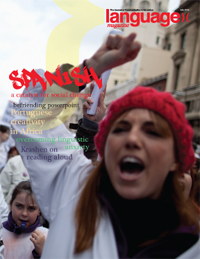 The European Union (EU) is pushing forward with its plans to counter Russian propaganda by boosting support for independent media in “Eastern Neighborhood” countries and increasing awareness of “disinformation activities by external actors,” according to a strategic communications action plan revealed by Radio Free Europe/Radio Liberty.
The European Union (EU) is pushing forward with its plans to counter Russian propaganda by boosting support for independent media in “Eastern Neighborhood” countries and increasing awareness of “disinformation activities by external actors,” according to a strategic communications action plan revealed by Radio Free Europe/Radio Liberty.
The main vehicle of the strategy is an EU communications unit called the East StratCom Team, which was launched in April but will be made permanent this fall and will support EU delegations in the six Eastern Neighborhood countries — which include Armenia,
Azerbaijan, and Belarus — as well as in Russia itself.
Russian Rumblings in Europe
Google to Focus on Indic Language Content
 India is now the second-largest online market in the world, but the Internet in India is predominantly an English only medium. Only 10% of India’s population speaks English, and, in an effort to promote digital literacy and safety in India, Prime Minister Narendra Modi announced the government’s Digital India Program, under which Google will increase the availability of information in Indic languages and help approximately 20 million small businesses establish a presence on the web. “Many of the next 100 to 200 million Indians who come online won’t speak English,” said Google Vice President and Managing Director for South East Asia and India, Rajan Anandan. “So, we have been working with 30 partners on the Indian Language Internet Alliance (ILIA) to make the web more useful to Indic language speakers.”
India is now the second-largest online market in the world, but the Internet in India is predominantly an English only medium. Only 10% of India’s population speaks English, and, in an effort to promote digital literacy and safety in India, Prime Minister Narendra Modi announced the government’s Digital India Program, under which Google will increase the availability of information in Indic languages and help approximately 20 million small businesses establish a presence on the web. “Many of the next 100 to 200 million Indians who come online won’t speak English,” said Google Vice President and Managing Director for South East Asia and India, Rajan Anandan. “So, we have been working with 30 partners on the Indian Language Internet Alliance (ILIA) to make the web more useful to Indic language speakers.”
The Twitter Hashtag is Officially a Word
 The children’s dictionary writers at Oxford University Press (OUP) named #, or hashtag, the UK children’s word of the year. Through the annual analysis of over 100,000 submissions to Radio 2’s 500 word short story competition, it was found that children under 13 years old are using the word creatively, as a form of emphasis or commenting in stories. What makes the word so remarkable is the new way it is being used. “Children are not tweeting and using Twitter, but they are using the word hashtag and the symbol # for dramatic effect, it is heightening tension,” said Vineeta Gupta, head of children’s dictionaries at OUP.
The children’s dictionary writers at Oxford University Press (OUP) named #, or hashtag, the UK children’s word of the year. Through the annual analysis of over 100,000 submissions to Radio 2’s 500 word short story competition, it was found that children under 13 years old are using the word creatively, as a form of emphasis or commenting in stories. What makes the word so remarkable is the new way it is being used. “Children are not tweeting and using Twitter, but they are using the word hashtag and the symbol # for dramatic effect, it is heightening tension,” said Vineeta Gupta, head of children’s dictionaries at OUP.
King Felipe VI’s Universal Spanish Language Proficiency Test
 Last month at the San Ildefonso College in Mexico City, Spain’s King Felipe VI and Queen Letizia launched the Siele, or the International Service for Evaluation of the Spanish Language, which is set to be a globally recognized Spanish language certificate encompassing the diversity of the language from all Spanish-speaking countries. “If we want to reaffirm Spanish as the world’s second language, we have to move beyond a short-term, self-self-absorbed vision and pool everyone’s resources to achieve a goal that will benefit us all,” said King Felipe VI of Spain in a speech during the king and queen’s official visit to Mexico where they championed the Spanish language as an engine of growth for the entire Spanish-speaking world. The test will determine a student’s Spanish skills, and can be administered practically anywhere on the planet.
Last month at the San Ildefonso College in Mexico City, Spain’s King Felipe VI and Queen Letizia launched the Siele, or the International Service for Evaluation of the Spanish Language, which is set to be a globally recognized Spanish language certificate encompassing the diversity of the language from all Spanish-speaking countries. “If we want to reaffirm Spanish as the world’s second language, we have to move beyond a short-term, self-self-absorbed vision and pool everyone’s resources to achieve a goal that will benefit us all,” said King Felipe VI of Spain in a speech during the king and queen’s official visit to Mexico where they championed the Spanish language as an engine of growth for the entire Spanish-speaking world. The test will determine a student’s Spanish skills, and can be administered practically anywhere on the planet.
July 2015

Telling Stories
Stephen Krashen on what to do and what not to do when reading aloud
Powering Pedagogy
Margaret Don offers solutions to the problems arising from using PowerPoint in the language classroom
Portuguese from Cape to Cape
Brazil may be the Portuguese powerhouse, but the language is still alive and well in Africa
Portuguese Immersion
Talk about tough decisions: Brazil or Portugal?
Spanish as a Vehicle for Social Change
Kristal Bivona, Sandra Ruiz and Daniel Ward discuss the movements and histories that made Spanish such an important language for activism
Global Spanish
One of the best things about learning Spanish is the diversity of places in which it is spoken — and taught
Fear and Loathing on the Acquisition Trail
Viviane Gontijo studies the intricate effects of second language anxiety
Last Writes
Richard Lederer with student bloopers on American history
Nevada Imposes Literacy by Third Grade
Nevada Go vernor Brian Sandoval has signed the Read by Three Act (SB 391) designed to improve early literacy and student achievement. The law includes early identification and parental notification of reading deficiencies, intensive reading interventions for students in need of additional support and, as a last resort, retention at the end of third grade with more intensive interventions.
vernor Brian Sandoval has signed the Read by Three Act (SB 391) designed to improve early literacy and student achievement. The law includes early identification and parental notification of reading deficiencies, intensive reading interventions for students in need of additional support and, as a last resort, retention at the end of third grade with more intensive interventions.
The law also requires progress monitoring plans for struggling readers, which prescribe the interventions that their schools will provide, learning support and professional development, and that school districts and charter schools report the number of students retained each year in third grade.
U.S. has more Spanish speakers than Spain
 The U.S. is now the world’s second largest Spanish-speaking country after Mexico, according to a new study published by Spain’s Instituto Cervantes. The report, El español, una lengua viva (Spanish, a living language) found that there are about 560 million Spanish speakers in the world, of which 41 million native speakers and 11.6 million speakers of Spanish as a second language (the majority of whom are bilingual) are documented as in the U.S.
The U.S. is now the world’s second largest Spanish-speaking country after Mexico, according to a new study published by Spain’s Instituto Cervantes. The report, El español, una lengua viva (Spanish, a living language) found that there are about 560 million Spanish speakers in the world, of which 41 million native speakers and 11.6 million speakers of Spanish as a second language (the majority of whom are bilingual) are documented as in the U.S.
With 52 million plus Spanish speakers, the U.S. has more than Colombia (48 million) and Spain (46 million) and is second only to Mexico (121 million). The report cites the U.S. Census Office as a source to support the claim that the country will have 138 million Spanish speakers by 2050, making it the biggest Spanish-speaking nation on Earth, with Spanish being the mother tongue of almost a third of its citizens.
Other key findings are:
- in 2015, there are estimated to be 470 million native speakers of Spanish.
- more than 21 million people are currently studying Spanish, of which 7.8 million are in the U.S.
- after Chinese, Spanish has the most mother-tongue speakers
- due to demographics, the percentage of world population that speaks Spanish is set to rise while the proportions speaking Chinese and English will decline
- Spanish is the third most widely-used language online
Click here to download the report in Spanish
#spanish #espanyol #latino usa
The Increasing Chinese Language Demand in Nigeria
 In Lagos, Nigeria more students are learning Chinese as economic ties between the West African country and China strengthen. China’s rapid economic expansion and the growth of a middle class meant a necessary turn to the African content to sustain an unprecedented demand for resources. China surpassed the United States as Africa’s largest trade partner in 2009, with Nigeria as one of the top five Sino-African partners. The demand for Mandarin Chinese has increased worldwide, but has begun to grow greatly in countries with Chinese trade relations, such as Nigeria, and other African nations with large Chinese expat communities. “I know we have schools across Lagos teaching Chinese language and that […] show[s] how the education sector is taking Chinese language serious,” said Jolade Oshodi, a Nigerian university graduate at the Confucius Institute at the University of Lagos in southwest Nigeria.
In Lagos, Nigeria more students are learning Chinese as economic ties between the West African country and China strengthen. China’s rapid economic expansion and the growth of a middle class meant a necessary turn to the African content to sustain an unprecedented demand for resources. China surpassed the United States as Africa’s largest trade partner in 2009, with Nigeria as one of the top five Sino-African partners. The demand for Mandarin Chinese has increased worldwide, but has begun to grow greatly in countries with Chinese trade relations, such as Nigeria, and other African nations with large Chinese expat communities. “I know we have schools across Lagos teaching Chinese language and that […] show[s] how the education sector is taking Chinese language serious,” said Jolade Oshodi, a Nigerian university graduate at the Confucius Institute at the University of Lagos in southwest Nigeria.
Where is Language in the Brain?
 In the well-known left and right brain divide, language has been placed as a logical function of the left. The center of language comprehension was thought to be the Wernicke’s area, named after Carl Wernicke who found in 1874 that stroke victims with damage to the left side of their brains commonly suffered from language impairment. However, it has been found that tonal languages use both sides of the brain due to the need to process different pitches. For tonal languages like Mandarin Chinese there are neural dynamics between the left side of the brain. In a recent study by Northwestern University, the Wernicke’s area was tested further. Regarding the language center of the brain, Marek-Marsel Mesulam, the study’s lead author, said, “There is no center but a network of interconnected areas, each with a slightly different specialization.”
In the well-known left and right brain divide, language has been placed as a logical function of the left. The center of language comprehension was thought to be the Wernicke’s area, named after Carl Wernicke who found in 1874 that stroke victims with damage to the left side of their brains commonly suffered from language impairment. However, it has been found that tonal languages use both sides of the brain due to the need to process different pitches. For tonal languages like Mandarin Chinese there are neural dynamics between the left side of the brain. In a recent study by Northwestern University, the Wernicke’s area was tested further. Regarding the language center of the brain, Marek-Marsel Mesulam, the study’s lead author, said, “There is no center but a network of interconnected areas, each with a slightly different specialization.”
Peru Officially Recognizes 24 Indigenous Languages
 The Peruvian Ministry of Education worked with indigenous communities to officially recognize the alphabets of 24 indigenous languages. The measure states; “Thus, these 24 alphabets should be used by public entities every time they have to issue written information addressed to these ethnic groups, as it is established by the Law 29735, which regulates the use, preservation, development, recovery, foster and spread of the indigenous languages of Peru […] In this way, the right of children and teenagers to be educated in their own native language is respected. It’s been proven that this is the way they can learn better, as they feel more motivated, their cultural identity is respected, and their self-esteem becomes stronger.”
The Peruvian Ministry of Education worked with indigenous communities to officially recognize the alphabets of 24 indigenous languages. The measure states; “Thus, these 24 alphabets should be used by public entities every time they have to issue written information addressed to these ethnic groups, as it is established by the Law 29735, which regulates the use, preservation, development, recovery, foster and spread of the indigenous languages of Peru […] In this way, the right of children and teenagers to be educated in their own native language is respected. It’s been proven that this is the way they can learn better, as they feel more motivated, their cultural identity is respected, and their self-esteem becomes stronger.”


